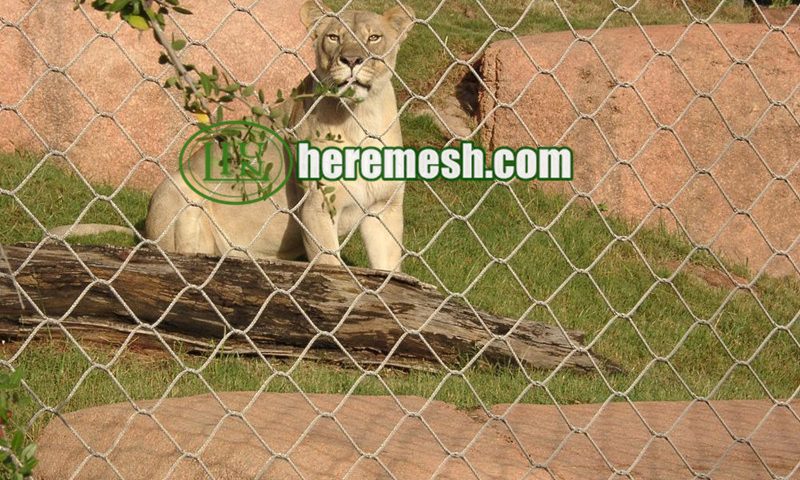Ecological Stainless Steel Zoo Animal Enclosure in Zoos

Deer Enclosure Solution: High-quality Deer Fence Mesh for Zoo and Farm
05/23/2025
The Key Role of Aviary Netting Order in Aviary Construction
05/30/2025The characteristics of stainless steel rope mesh
Stainless steel rope mesh, as a new type of material for zoo animal enclosure, has been widely used in the construction of zoos around the world in recent years. This material is woven from high-quality stainless steel wire through a special process. And it has many advantages that traditional fences cannot match. Wire rope mesh has extremely high tensile strength and durability, and can withstand the impact and biting of large animals. The stainless steel material of grade 304 or 316 endows it with excellent rust and corrosion resistance. Even when exposed to a damp environment or animal excrement for a long time, stainless steel will not corrode, greatly extending its service life.
The stainless steel rope mesh has excellent flexibility and can undergo moderate deformation when hit by animals, effectively buffering the impact force. This feature not only protects the safety of animals but also reduces the risk of damage to the enclosure structure. This concept of “flexible protection” conforms to the requirements of animal welfare in modern zoos. Meanwhile, the structure of the rope mesh ensures good ventilation and light transmission. It will not cause a sense of oppression in a closed space and is beneficial to the mental health of animals. From the perspective of viewing, stainless steel rope mesh causes less visual interference, allowing visitors to observe the natural behaviors of animals more clearly and enhancing the visiting experience.
Compared with traditional iron enclosure, stainless steel rope mesh is 30% to 50% lighter in weight. The lightweight design significantly reduces transportation and installation costs. Its design allows for flexible adjustment of the size and shape of the enclosure to meet the spatial requirements of different species. In terms of maintenance, zoo animal enclosure requires almost no special care. It only needs regular rinsing with clean water to maintain its appearance, saving a lot of manpower and material resources. Environmental friendliness is also its prominent advantage. Stainless steel materials can be 100% recycled and reused, which is in line with the concept of sustainable zoo construction.
Key points for the design of zoo animal enclosure
Big cat animals
The design of zoo animal enclosure should follow the principle of differentiation in light of the biological characteristics and behavioral needs of different groups of animals. For big cat animals, such as lions and tigers, safety must be given top priority in the enclosure. Usually, high-strength stainless steel ropes with a diameter of 3.2mm are used. And the mesh opening does not exceed 76mm to prevent animal limbs from protruding. The height of the enclosure is generally no less than 5 meters, and an inward-sloping anti-climbing structure should be set at the top. To satisfy the climbing nature of animals, three-dimensional climbing frames made of stainless steel rope nets can be set up in the enclosure, which is both safe and can enrich the animals’ behaviors.
Primate animals
The design of the enclosures in primate zoos pays more attention to preventing their dexterous fingers from grasping and escaping. The selection of primate enclosure mesh specifications needs to be based on the size of the primate’s body. Small primates can choose stainless steel rope mesh with a rope diameter of 1.6mm-2.0mm. Large primates need to choose rope mesh ranging from 2.4mm to 3.2mm. The top of the zoo animal enclosure must be completely enclosed because most primates are good at climbing. Multi-level three-dimensional Spaces can be designed. And facilities such as suspension Bridges and platforms can be combined to simulate the three-dimensional environment of natural habitats. It is particularly important to note that the edges of the enclosure should be smoothed to prevent injuries.
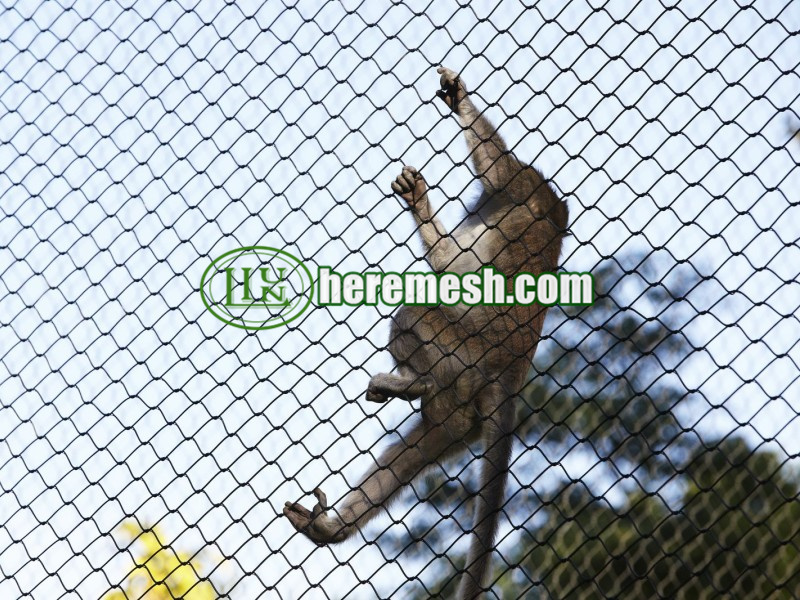
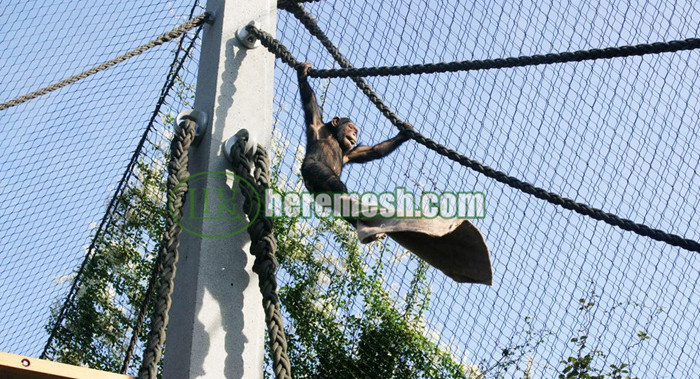
Ungulate mammals
Large zoo animal enclosure of ungulates such as giraffes and rhinos, mainly considering their running and head-to-head behaviors. The enclosure posts need to be specially reinforced, and the foundation depth should be no less than 1 meter. The mesh opening within a height of 50cm at the bottom should be denser to prevent the animal’s legs from getting stuck. For tall animals like giraffes, the height of the enclosure usually needs to reach more than 6 meters. The elasticity of zoo animal enclosure can effectively absorb the impact energy of large ungulates, reducing the damage to animals and fences.
Bird enclosure
The application of stainless steel rope mesh in bird and animal enclosures has unique advantages. The lightweight rope net does not affect flight, while the fine grid can prevent birds of all sizes from escaping. Stainless steel wire rope with diameters ranging from 1.2m to 1.6mm are sufficient to meet the needs of most bird enclosures. To adapt to the habits of different birds, zones for flying and traveling birds can be designed and naturally separated by rope mesh. The design of an open top should be accompanied by appropriate anti-flying measures, such as tilted mesh surfaces or visual obstructions.
Structural design & engineering of zoo animal enclosure
High quality animal enclosure projects begin with scientific structural design. Zoo animal enclosure is usually composed of three main parts: the support system, the connection system, the rope mesh body. The support system is mostly made of hot-dip galvanized steel pipes or concrete pillars, whose corrosion resistance matches that of the stainless steel rope mesh. The spacing of the columns is determined according to the animal species and the tension of the rope net, usually 2-4 meters. Foundation design needs to consider local soil conditions and depth of permafrost to ensure overall stability.
Connection system is the key link of safety. Special stainless steel ferrules need to have enough clamping force and anti-loosening design. Corner parts need to be specially reinforced, and double pillars or curved transition design can be used.
Rope mesh tensioning technology directly affects the performance of the enclosure. Generally keep the working tension of rope netting at 15%-20% of the breaking tension. Professional tensioning tools and force measuring instruments ensure that the tension is evenly distributed. Boundary treatments need to be firmly fixed and hidden at the end of the rope mesh to prevent animals from contacting the sharp edges. Acceptance of the work should include static load tests and simulated animal impact tests to ensure strength in all directions is up to standard.
Animal welfare during construction should not be overlooked. New zoo animal enclosure should be built in consideration of animal living habits. For the type of active animals, the design of animal enclosure should be appropriate to increase the area of animal activities. Wide activity space reduces the generation of stereotyped animal behavior.
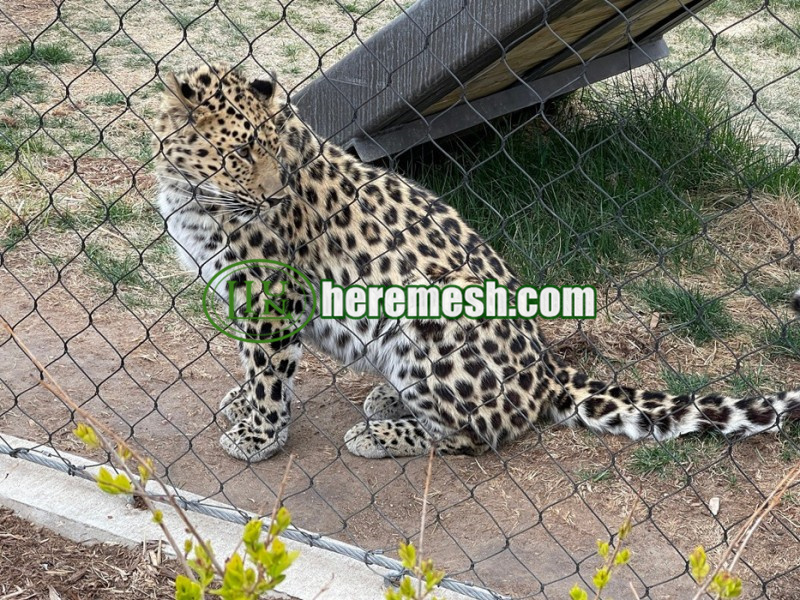
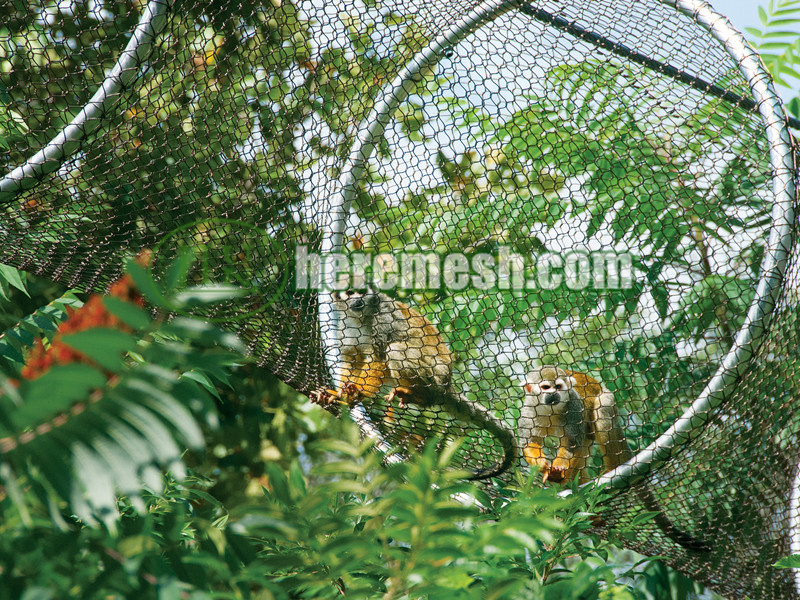
Enrichment of animal behaviors in zoo animal Enclosure
Modern zoos emphasize promoting the expression of animals’ natural behaviors through environmental enrichment. And stainless steel rope mesh demonstrates unique value in this regard. Its flexible characteristics allow for the design of various three-dimensional structures and stimulate animal behavior. A three-dimensional tunnel system can be designed within the enclosure to increase the diversity of activities. These facilities can not only meet the physiological needs of animals, but also effectively reduce the occurrence of stereotyped behaviors.
The construction of the community environment is an important consideration in enclosure design. Stainless steel rope mesh can create adjacent spaces that are visually accessible but physically isolated, helping animals build social relationships. The exhibition areas of similar species are connected by adopting a tunnel design. This design facilitates group interaction and is beneficial to the physical and mental health of animals. The flexible enclosure design provides a dynamic living environment for animals.
Integration of visitor experience and educational functions
Zoo animal enclosure has significant advantages in enhancing the visitor experience. Its nearly invisible feature offers an unobstructed viewing view, combined with the natural exhibition area design. The panoramic observation points are set up to allow visitors to observe the animals from multiple angles, including high-altitude observation platforms and underground observation corridors. All of these require the rope nets to have different specifications of light transmission and strength.
The design of the rope mesh in the interactive experience area should take into account both safety and a sense of participation. Appropriate mesh opening allows visitors to have limited contact with docile animals. Such as the observation of primate grooming behavior or the feeding interaction of birds. The touch information board can be fixed on the rope mesh to introduce the characteristics of species and the current status of conservation. The sound duct system transmits animal sounds through a rope mesh structure, enhancing the immersive experience.
The educational function is the core mission of modern zoos. The stainless steel zoo animal enclosure integrates multiple educational elements. Zoos improve animal welfare through technological innovation to ensure that both animals and visitors can enjoy a good experience. Compared with traditional closed cages, modern rope mesh enclosures can guide tourists to protect animals and restore their ecological habitats. Highly visible enclosure provides visitors with a low-pressure observation environment, helping them perceive the forms of animals. These humanized designs all rely on the flexible application methods of stainless steel rope nets.
Hygiene and long-term sustainability of zoo animal enclosure
Although the stainless steel zoo animal enclosure is known for its low maintenance, a scientific maintenance system still needs to be established. Reasonable maintenance is conducive to the long-term function of the enclosure mesh. Daily inspections should include rope mesh tension tests, checks on the firmness of connectors, and surface damage assessments. Monthly maintenance focuses on cleaning and disinfection. The annual major inspection conducts a comprehensive assessment of the overall structural safety. Reasonable management and maintenance extend the life cycle of materials. The service life of stainless steel rope mesh is usually over 20 years and it can be completely recycled after being phased out. Compared with traditional fences, its carbon footprint throughout the entire life cycle is reduced by more than 40%.
To ensure the health of the animals, the enclosure also needs to be cleaned and disinfected regularly. Removing dirt from the surface of the rope net can effectively prevent the spread of bacteria and viruses.
Conclusion
Animal protection education will be strengthened through enclosure design. The use of these innovative materials will transform the zoo from a mere exhibition venue into a comprehensive conservation and education center.
The stainless steel zoo animal enclosure represents the advanced concept of modern zoo design. Through the integration of material innovation and design wisdom, it achieves an outstanding balance among animal welfare, visitor experience, educational functions and operational efficiency. With the continuous advancement of technology, this enclosure form is bound to inject new vitality into the development of the zoo industry and promote the wildlife protection cause to a higher level.


